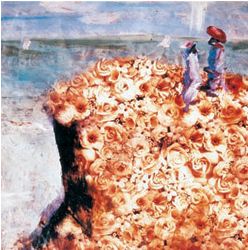Classic Image
By Leila Rehman | Art | Arts & Culture | Published 22 years ago
 Ahmed Ali Manganhar’s recent display of paintings, ‘Monet & Co,’ at Rohtas 2 in Lahore, took viewers by surprise. The reason for this was the open, honest manner of engagement with materials, surface and content, that the painter had so obviously enjoyed and it was this quality that first came across to the viewer. As these are not qualities apparent in every offering to the art world, it certainly deserves a mention.
Ahmed Ali Manganhar’s recent display of paintings, ‘Monet & Co,’ at Rohtas 2 in Lahore, took viewers by surprise. The reason for this was the open, honest manner of engagement with materials, surface and content, that the painter had so obviously enjoyed and it was this quality that first came across to the viewer. As these are not qualities apparent in every offering to the art world, it certainly deserves a mention.
The surface was the initial unexpected element in Manganhar’s work, for instead of the usual watercolour paper, board, wood panel or canvas, he had painted on gift paper. Why gift paper, one might ask? What he achieves with this medium, is a spontaneity and a joie- de-vivre. While he maintains the same scale throughout the 18 paintings on show, ( 20″ x 30″ — the actual size of gift paper), the variety in design, the particular choice of (painted) excerpts from the impressionist school or High Renaissance, and their juxtaposing was where the mettle of this painter showed. His placing of Velasquez’s famous self-portrait against a repeated diamond-shaped pattern, which reflected the somber tones in his clothes, had one doing a double-take. We see Van Gogh against a ‘wallpaper’ of sunflowers; we see the all too familiar, (yet in this context, a little unfamiliar), vase of sunflowers against yet more flowers, set in a pattern of checks and squares. Degas is pictured in an almost magic-eye surface of flowers and leaves, which seems to make him almost walk out of the picture plane. These are all painted forms and images. It is in the clever use of the gift paper as background, cliff-top, garden, lake and so on that the painter engages our attention. It is precisely in these flights of fancy that Manganhar’s strength as an artist lies.
What comes through strongly is, however, an element one would like to see developed further. In not experimenting with the scale, the artist leaves the viewer wondering what impact an image would make if, for example, an entire wall was covered with gift paper (always aptly chosen) and painted over in sure strokes, bringing well known faces to life.
 Manganhar’s innate sense of space, balance and composition have allowed him to create an image like ‘The heights of impressionism.’ It requires not only a sure hand, confident of the materials it uses, but an inner sense of what a composition should be like, to create such a complete image.
Manganhar’s innate sense of space, balance and composition have allowed him to create an image like ‘The heights of impressionism.’ It requires not only a sure hand, confident of the materials it uses, but an inner sense of what a composition should be like, to create such a complete image.
The artist’s wonderfully piquant use of painters like Monet, Carravagio, Zahoor-ul-Akhlaque and Velasquez, against these backdrops of repeated flowers, stems and geometric shapes, also recall a stage-setting with painted backdrops. It contains a pixie-like quality which in no way demeans the essence of the originals, rather it underlines the painter’s debt to these giants of the art world. What is refreshing is that we as viewers feel no awe in viewing this work, which is a customary reflex upon entering the hallowed space of an exhibition hall. There is, rather, a sense of immediacy that is appealing and allows the viewer to see not only Manganhar’s paintings but to think anew of the originals that inspired him.
They serve to connect us in the present day to these well-worn images from our past. It is their veracity and enduring quality that is enhanced.


